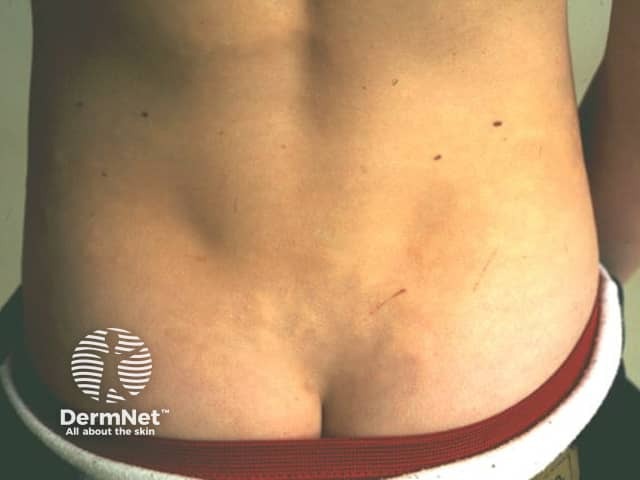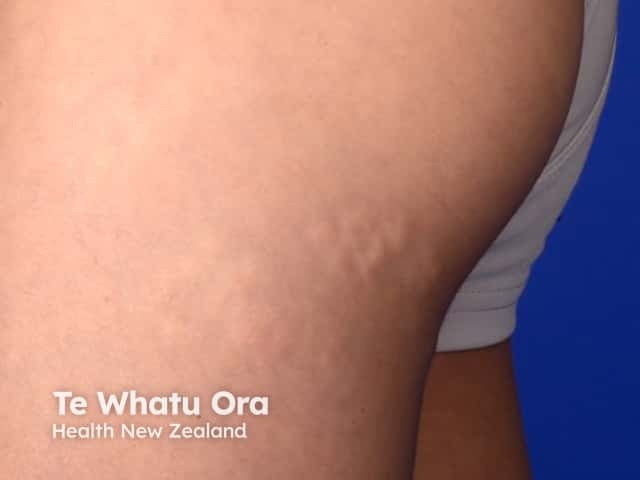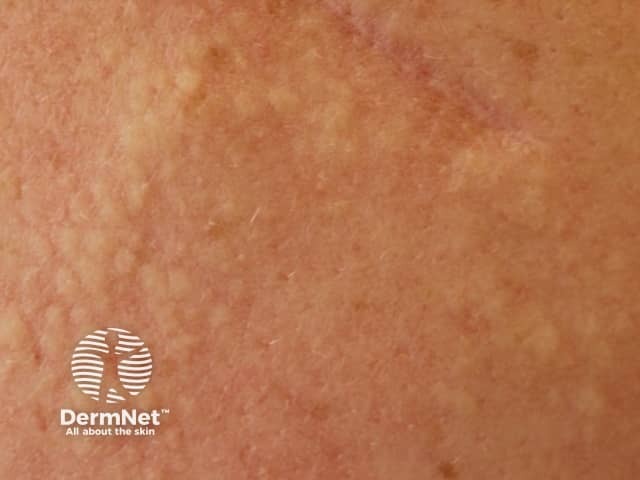Main menu
Common skin conditions

NEWS
Join DermNet PRO
Read more
Quick links
Buschke–Ollendorff syndrome — extra information
Buschke–Ollendorff syndrome
Author: Brian Wu, MD candidate, Keck School of Medicine, Los Angeles, USA. DermNet New Zealand Editor in Chief: Hon A/Prof Amanda Oakley, Dermatologist, Hamilton, New Zealand. December 2016.
Introduction Demographics Causes Clinical features Treatment Outcome
What is Buschke–Ollendorff syndrome?
Buschke–Ollendorff syndrome refers to a rare, hereditary disorder affected the connective tissues. It is also known as dermatofibrosis lenticularis disseminata, dermato-osteopoikilosis and familial cutaneous collagenoma.
Who gets Buschke–Ollendorff syndrome?
Buschke–Ollendorff syndrome occurs in 1 in every 20,000 live births worldwide. There appears to be no racial, sexual or geographical predilection. Lesions are present at birth.
What causes Buschke–Ollendorff syndrome?
Buschke–Ollendorff syndrome is a genetic disease. The underlying cause of Buschke–Ollendorff syndrome is mutation of the LEMD3 gene, which provides instructions for the making of proteins that support connective tissues.
- Inheritance is in an autosomal dominant pattern with incomplete penetrance. The child of someone with the syndrome has a 50% chance of inheriting the faulty LEMD3 gene but may not actually develop the syndrome.
- It may result from abnormal regulation of the extracellular matrix, which results in a build-up of elastin in the dermal layer of skin.
What are the clinical features of Buschke–Ollendorff syndrome?
Buschke–Ollendorff syndrome is characterised by small connective tissue naevi.
- The torso and extremities are most often affected.
- The naevi are elastomas (made from elastin fibres), collagenomas (made from collagen fibres) or fibromas (made from fibrous tissue).
- They are slightly elevated, yellowish papules, nodules or plaques.
- These lesions are painless and do not itch.
Non-cutaneous but significant features of Buschke–Ollendorff syndrome include:
- Osteopoikilosis (areas of increased bone density on the long bones of the limbs)
- Nasolacrimal (tear) duct obstruction
- Amblyopia (lazy eye) or strabismus (squint)
- Benign lymphoid hyperplasia (growth of lymph tissue)
- Short stature
- Diabetes mellitus
- Aortic stenosis (restricted heart valve)
- Hearing impairment/deafness.

Conenctive tissue naevus in Buschke Ollendorf syndrome

Connective tissue naevus

Connective tissue naevus
How is Buschke–Ollendorff syndrome treated?
The treatment of Buschke–Ollendorff syndrome may involve:
- Surgical excision of the connective tissue naevi for cosmetic reasons
- Surgical treatment of deafness, if indicated
- Surgical or other treatment of associated disorders, such as diabetes mellitus or aortic stenosis.
What is the outcome for Buschke–Ollendorff syndrome?
The outcome for Buschke–Ollendorff syndrome depends on the associated disorders.
- A leading cause of mortality related to Buschke–Ollendorff syndrome is the development of areas of bone density into bone cancers such as osteosarcoma, chondrosarcoma or giant cell tumours.
- When other disorders like aortic stenosis or diabetes mellitus are present, the prognosis can be serious.
References
- Genetics Home Reference, US National Library of Medicine. Buschke-Ollendorff syndrome. 2013. Available at: https://ghr.nlm.nih.gov/condition/buschke-ollendorff-syndrome (accessed July 2016).
- Genetic Testing Registry. Dermatofibrosis lenticularis disseminata. 2014. Available at: http://www.ncbi.nlm.nih.gov/gtr/conditions/C0265514 (accessed July 2016).
- Matusiak L; Medscape. Dermatofibrosis (Buschke-Ollendorff syndrome). April 2016. Available at: http://emedicine.medscape.com/article/1117654-overview (accessed July 2016).
On DermNet
Other websites
- Buschke-Ollendorff syndrome; BOS — OMIM
- Buschke Ollendorff syndrome — Genetic and Rare Diseases Information Center, US National Institutes of Health
